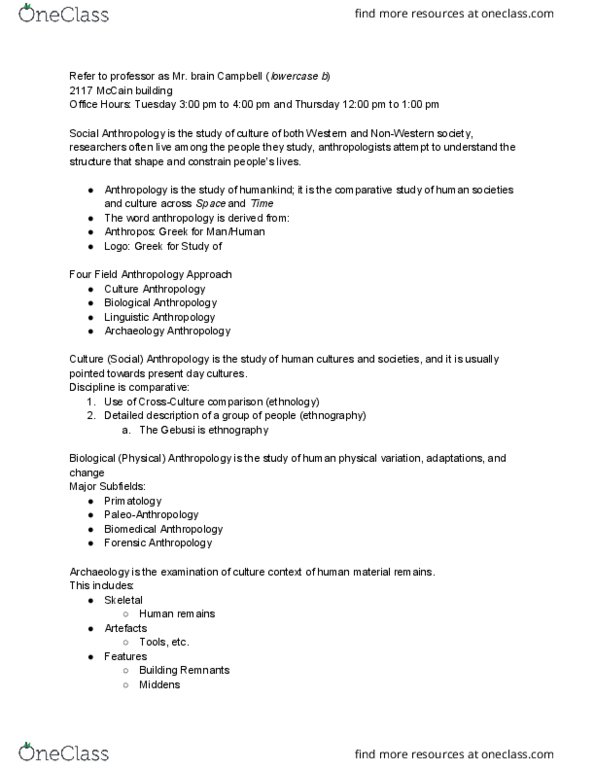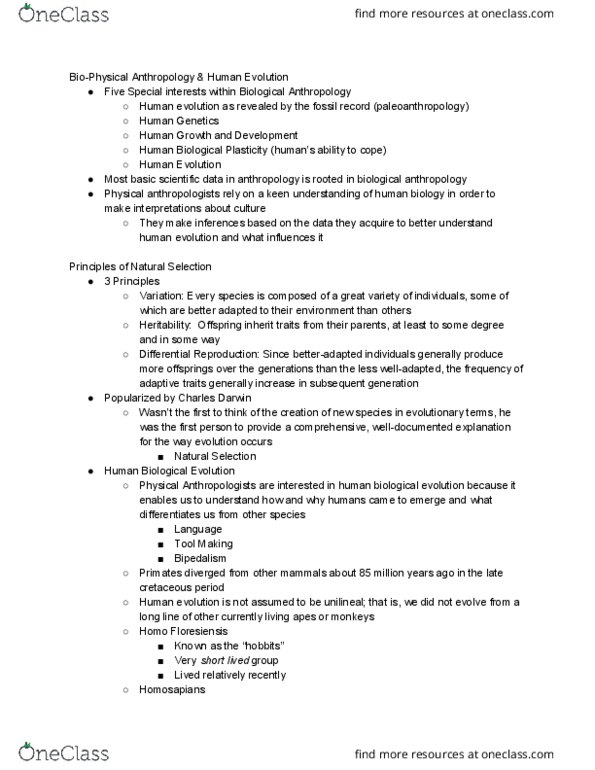SOSA 1002 Lecture Notes - Lecture 2: Human Variability, Participant Observation, Moral Relativism
SOSA 1002 verified notes
2/2View all

Bio-Physical Anthropology & Human Evolution
● Five Special interests within Biological Anthropology
○ Human evolution as revealed by the fossil record (paleoanthropology)
○ Human Genetics
○ Human Growth and Development
○ Human Biological Plasticity (human’s ability to cope)
○ Human Evolution
● Most basic scientific data in anthropology is rooted in biological anthropology
● Physical anthropologists rely on a keen understanding of human biology in order to
make interpretations about culture
○ They make inferences based on the data they acquire to better understand
human evolution and what influences it
Principles of Natural Selection
● 3 Principles
○ Variation: Every species is composed of a great variety of individuals, some of
which are better adapted to their environment than others
○ Heritability: Offspring inherit traits from their parents, at least to some degree
and in some way
○ Differential Reproduction: Since better-adapted individuals generally produce
more offsprings over the generations than the less well-adapted, the frequency of
adaptive traits generally increase in subsequent generation
● Popularized by Charles Darwin
○ Wasn’t the first to think of the creation of new species in evolutionary terms, he
was the first person to provide a comprehensive, well-documented explanation
for the way evolution occurs
■ Natural Selection
● Human Biological Evolution
○ Physical Anthropologists are interested in human biological evolution because it
enables us to understand how and why humans came to emerge and what
differentiates us from other species
■ Language
■ Tool Making
■ Bipedalism
○ Primates diverged from other mammals about 85 million years ago in the late
cretaceous period
○ Human evolution is not assumed to be unilineal; that is, we did not evolve from a
long line of other currently living apes or monkeys
○ Homo Floresiensis
■ Known as the “hobbits”
■ Very short lived
group
■ Lived relatively recently
○ Homosapians

■ The only living human
on Earth today
○ Hominids
■ The group consisting of all modern and extinct Great Apes
● Great Apes are modern humans, bonobos, chimps, gorillas, and
orangutans and all their immediate evolutionary ancestor
○ Hominins
■ The group consisting of modern humans, extinct human species, and all
of our immediate ancestors
● Humans are the only living hominins
○ Monkeys VS Apes
■ Makeys are smaller than apes
■ Most monkeys have tails, while apes do not
■ Monkeys live in arboreal habitats
■ Monkey’s rely on braciation to swing through trees
■ Apes are more clever than monkeys
■ Apes are capable of learning sign language
● Koko the Ape knew over 1000 signs
● Possible that the only thing stopping Apes from speaking is their
vocal cords can not handle it
■ Apes have larger brains than monkeys
○ Anatomical Changes and Human Evolution Encephalization
■ The human species developed a much larger brain than that of other
primates
● Typically 1330 cm3
■ The reduced degree of sexual dimorphism is visible primarily in the
reduction of the male canine tooth relative to other ape species
■ Humans are the only ape (except bonobos) in which females are fertile all
year round
■ Humans retain sexual dimorphism in the distribution of body hair and fat
○ Biological Capacity for Culture
■ Human Speech and Language
● Humans have a unique brain structure and that enables us to
produce and understand speech
○ The Broca and Wernicke's area
■ Tool Making
● The upper part of the motor cortex in the brain is believed to
enable us to make and use tools
● Prehensile fingers, hands, and arms allows for us to make and
use tools
● Bipedalism allows us to use our hands in ways that other animals
can't
● Value of Comparing the Past and Present
○ Looking at archaic hominins allows us to make inferences about evolution
Document Summary
Human evolution as revealed by the fossil record (paleoanthropology) Human biological plasticity (human"s ability to cope) Most basic scientific data in anthropology is rooted in biological anthropology. Physical anthropologists rely on a keen understanding of human biology in order to make interpretations about culture. They make inferences based on the data they acquire to better understand human evolution and what influences it. Variation: every species is composed of a great variety of individuals, some of which are better adapted to their environment than others. Heritability: offspring inherit traits from their parents, at least to some degree and in some way. Differential reproduction: since better-adapted individuals generally produce more offsprings over the generations than the less well-adapted, the frequency of adaptive traits generally increase in subsequent generation. Wasn"t the first to think of the creation of new species in evolutionary terms, he was the first person to provide a comprehensive, well-documented explanation for the way evolution occurs.



